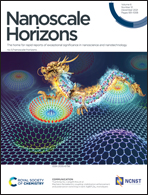Spatial confinement of chemically engineered cancer cells using large graphene oxide sheets: a new mode of cancer therapy†
Abstract
Treating cancer with high efficacy while eliminating side effects has been the holy grail of cancer research. The challenge, however, arises from the similarity in molecular traits of cancer cells and normal cells because truly specific cancer biomarkers are extremely scarce if not entirely unavailable. Often, biomarkers serving as the therapeutic targets are present on both healthy cells and cancers, but at different levels, causing not only off-target side effects but also on-target side effects. This work has reported a new concept of cancer treatment, spatial confinement of cells to inhibit cell migration and invasion, which directly addresses the defining trait of cancer on the cellular level, unchecked division. Using large sized graphene oxide (LS-GO), cell surfaces can be patched. Unlike conventional chemotherapy, this spatial confinement does not affect the viability of non-dividing cells but significantly inhibits tumor cell migration and invasion in vitro and in vivo. This new concept has the potential to become a general therapeutic for many cancer types with reduced side effects.

- This article is part of the themed collection: Nanoscale and Nanoscale Horizons: Nanobiotechnology and Nanomedicine


 Please wait while we load your content...
Please wait while we load your content...